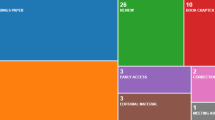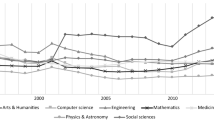Abstract
The increasing use of AI methods in various applications has raised concerns about their explainability and transparency. Many solutions have been developed within the last few years to either explain the model itself or the decisions provided by the model. However, the number of contributions in the field of eXplainable AI (XAI) is increasing at such a high pace that it is almost impossible for a newcomer to identify key ideas, track the field’s evolution, or find promising new research directions.
Typically, survey papers serve as a starting point, providing a feasible entry point into a research area. However, this is not trivial for some fields with exponential growth in the literature, such as XAI. For instance, we analyzed 23 surveys in the XAI domain published within the last three years and surprisingly found no common conceptualization among them. This makes XAI one of the most challenging research areas to enter. To address this problem, we propose a systematic approach that enables newcomers to identify the principal ideas and track their evolution. The proposed method includes automating the retrieval of relevant papers, extracting their semantic relationship, and creating a temporal graph of ideas by post-analysis of citation graphs.
The main outcome of our method is Field’s Evolution Graph (FEG), which can be used to find the core idea of each approach in this field, see how a given concept has developed and evolved over time, observe how different notions interact with each other, and perceive how a new paradigm emerges through combining multiple ideas. As for demonstration, we show that FEG successfully identifies the field’s key articles, such as LIME or Grad-CAM, and maps out their evolution and relationships.
Access this chapter
Tax calculation will be finalised at checkout
Purchases are for personal use only
Similar content being viewed by others
References
Abu-Jbara, A., Radev, D.: Coherent citation-based summarization of scientific papers. In: Proceedings of the 49th Annual Meeting of the Association for Computational Linguistics: Human Language Technologies, pp. 500–509 (2011)
Adebayo, J., Gilmer, J., Muelly, M., Goodfellow, I., Hardt, M., Kim, B.: Sanity checks for saliency maps. In: Advances in Neural Information Processing Systems, vol. 31 (2018)
Bach, S., Binder, A., Montavon, G., Klauschen, F., Müller, K.R., Samek, W.: On pixel-wise explanations for non-linear classifier decisions by layer-wise relevance propagation. PLoS ONE 10(7), e0130140 (2015)
Baehrens, D., Schroeter, T., Harmeling, S., Kawanabe, M., Hansen, K., Müller, K.R.: How to explain individual classification decisions. J. Mach. Learn. Res. 11, 1803–1831 (2010)
Bahdanau, D., Cho, K., Bengio, Y.: Neural machine translation by jointly learning to align and translate. arXiv preprint arXiv:1409.0473 (2014)
Bau, D., Zhou, B., Khosla, A., Oliva, A., Torralba, A.: Network dissection: quantifying interpretability of deep visual representations. In: Proceedings of the IEEE Conference on Computer Vision And Pattern Recognition, pp. 6541–6549 (2017)
Bien, J., Tibshirani, R.: Prototype selection for interpretable classification. Ann. Appl. Statist. 5(4), 2403–2424 (2011)
Caruana, R., Lou, Y., Gehrke, J., Koch, P., Sturm, M., Elhadad, N.: Intelligible models for healthcare: Predicting pneumonia risk and hospital 30-day readmission. In: Proceedings of the 21th ACM SIGKDD International Conference on Knowledge Discovery and Data Mining, pp. 1721–1730 (2015)
Chen, J., Zhuge, H.: Automatic generation of related work through summarizing citations. Concurr. Comput. Pract. Exp. 31(3), e4261 (2019)
Craven, M., Shavlik, J.: Extracting tree-structured representations of trained networks. In: Advances in Neural Information Processing Systems, vol. 8 (1995)
Dabkowski, P., Gal, Y.: Real time image saliency for black box classifiers. In: Advances in Neural Information Processing Systems, vol. 30 (2017)
Danilevsky, M., Qian, K., Aharonov, R., Katsis, Y., Kawas, B., Sen, P.: A survey of the state of explainable ai for natural language processing. arXiv preprint arXiv:2010.00711 (2020)
Datta, A., Sen, S., Zick, Y.: Algorithmic transparency via quantitative input influence: theory and experiments with learning systems. In: 2016 IEEE Symposium on Security and Privacy (SP), pp. 598–617. IEEE (2016)
Fink, O., Wang, Q., Svensen, M., Dersin, P., Lee, W.J., Ducoffe, M.: Potential, challenges and future directions for deep learning in prognostics and health management applications. Eng. Appl. Artif. Intell. 92, 103678 (2020)
Fong, R.C., Vedaldi, A.: Interpretable explanations of black boxes by meaningful perturbation. In: Proceedings of the IEEE International Conference on Computer Vision, pp. 3429–3437 (2017)
Hannousse, A.: Searching relevant papers for software engineering secondary studies: semantic scholar coverage and identification role. IET Softw. 15(1), 126–146 (2021)
Hendricks, L.A., Akata, Z., Rohrbach, M., Donahue, J., Schiele, B., Darrell, T.: Generating visual explanations. In: Leibe, B., Matas, J., Sebe, N., Welling, M. (eds.) ECCV 2016. LNCS, vol. 9908, pp. 3–19. Springer, Cham (2016). https://doi.org/10.1007/978-3-319-46493-0_1
Huysmans, J., Dejaeger, K., Mues, C., Vanthienen, J., Baesens, B.: An empirical evaluation of the comprehensibility of decision table, tree and rule based predictive models. Decis. Support Syst. 51(1), 141–154 (2011)
Kan, M.S., Tan, A.C., Mathew, J.: A review on prognostic techniques for non-stationary and non-linear rotating systems. Mech. Syst. Signal Process. 62, 1–20 (2015)
Kim, B., Khanna, R., Koyejo, O.O.: Examples are not enough, learn to criticize! criticism for interpretability. In: Advances in Neural Information Processing Systems, vol. 29 (2016)
Kim, B., Wattenberg, M., Gilmer, J., Cai, C., Wexler, J., Viegas, F., et al.: Interpretability beyond feature attribution: Quantitative testing with concept activation vectors (TCAV). In: International Conference on Machine Learning, pp. 2668–2677. PMLR (2018)
Koh, P.W., Liang, P.: Understanding black-box predictions via influence functions. In: International Conference on Machine Learning, pp. 1885–1894. PMLR (2017)
Lakkaraju, H., Kamar, E., Caruana, R., Leskovec, J.: Interpretable and explorable approximations of black box models. arXiv preprint arXiv:1707.01154 (2017)
Letham, B., Rudin, C., McCormick, T.H., Madigan, D.: Interpretable classifiers using rules and Bayesian analysis: building a better stroke prediction model. Ann. Appl. Statist. 9(3), 1350–1371 (2015)
Li, W., Xiao, X., Liu, J., Wu, H., Wang, H., Du, J.: Leveraging graph to improve abstractive multi-document summarization. arXiv preprint arXiv:2005.10043 (2020)
Lundberg, S.M., Lee, S.I.: A unified approach to interpreting model predictions. Advances in Neural Information Processing Systems, vol. 30 (2017)
Mahendran, A., Vedaldi, A.: Understanding deep image representations by inverting them. In: Proceedings of the IEEE Conference on Computer Vision and Pattern Recognition, pp. 5188–5196 (2015)
Markus, A.F., Kors, J.A., Rijnbeek, P.R.: The role of explainability in creating trustworthy artificial intelligence for health care: a comprehensive survey of the terminology, design choices, and evaluation strategies. J. Biomed. Inform. 113, 103655 (2021)
Miller, T.: Explanation in artificial intelligence: insights from the social sciences. Artif. Intell. 267, 1–38 (2019)
Montavon, G., Lapuschkin, S., Binder, A., Samek, W., Müller, K.R.: Explaining nonlinear classification decisions with deep Taylor decomposition. Pattern Recogn. 65, 211–222 (2017)
Nguyen, A., Dosovitskiy, A., Yosinski, J., Brox, T., Clune, J.: Synthesizing the preferred inputs for neurons in neural networks via deep generator networks. In: Advances in Neural Information Processing Systems, vol. 29 (2016)
Nguyen, A., Yosinski, J., Clune, J.: Deep neural networks are easily fooled: high confidence predictions for unrecognizable images. In: Proceedings of the IEEE Conference on Computer Vision and Pattern Recognition, pp. 427–436 (2015)
Nikiforovskaya, A., Kapralov, N., Vlasova, A., Shpynov, O., Shpilman, A.: Automatic generation of reviews of scientific papers. In: 2020 19th IEEE International Conference on Machine Learning and Applications (ICMLA), pp. 314–319. IEEE (2020)
Rezaeianjouybari, B., Shang, Y.: Deep learning for prognostics and health management: state of the art, challenges, and opportunities. Measurement 163, 107929 (2020)
Ribeiro, M.T., Singh, S., Guestrin, C.: “why should i trust you?” Explaining the predictions of any classifier. In: Proceedings of the 22nd ACM SIGKDD International Conference on Knowledge Discovery and Data Mining, pp. 1135–1144 (2016)
Ribeiro, M.T., Singh, S., Guestrin, C.: Anchors: High-precision model-agnostic explanations. In: Proceedings of the AAAI Conference on Artificial Intelligence, vol. 32 (2018)
Robnik-Šikonja, M., Kononenko, I.: Explaining classifications for individual instances. IEEE Trans. Knowl. Data Eng. 20(5), 589–600 (2008)
Ross, A.S., Hughes, M.C., Doshi-Velez, F.: Right for the right reasons: training differentiable models by constraining their explanations. arXiv preprint arXiv:1703.03717 (2017)
Samek, W., Binder, A., Montavon, G., Lapuschkin, S., Müller, K.R.: Evaluating the visualization of what a deep neural network has learned. IEEE Trans. Neural Netw. Learn. Syst. 28(11), 2660–2673 (2016)
Selvaraju, R.R., Cogswell, M., Das, A., Vedantam, R., Parikh, D., Batra, D.: Grad-cam: Visual explanations from deep networks via gradient-based localization. In: Proceedings of the IEEE International Conference on Computer Vision, pp. 618–626 (2017)
Shrikumar, A., Greenside, P., Kundaje, A.: Learning important features through propagating activation differences. In: International Conference on Machine Learning, pp. 3145–3153. PMLR (2017)
Simonyan, K., Vedaldi, A., Zisserman, A.: Deep inside convolutional networks: visualising image classification models and saliency maps. In: Workshop at International Conference on Learning Representations. Citeseer (2014)
Smilkov, D., Thorat, N., Kim, B., Viégas, F., Wattenberg, M.: Smoothgrad: removing noise by adding noise. arXiv preprint arXiv:1706.03825 (2017)
Springenberg, J.T., Dosovitskiy, A., Brox, T., Riedmiller, M.: Striving for simplicity: the all convolutional net. arXiv preprint arXiv:1412.6806 (2014)
Sun, X., Zhuge, H.: Automatic generation of survey paper based on template tree. In: 2019 15th International Conference on Semantics, Knowledge and Grids (SKG), pp. 89–96. IEEE (2019)
Sundararajan, M., Taly, A., Yan, Q.: Axiomatic attribution for deep networks. In: International Conference on Machine Learning, pp. 3319–3328. PMLR (2017)
Tjoa, E., Guan, C.: A survey on explainable artificial intelligence (XAI): toward medical XAI. IEEE Trans. Neural Netw. Learn. Syst. 32(11), 4793–4813 (2020)
Tohalino, J.V., Amancio, D.R.: Extractive multi-document summarization using multilayer networks. Physica A 503, 526–539 (2018)
Vaswani, A., et al.: Attention is all you need. In: Advances in Neural Information Processing Systems, vol. 30 (2017)
Wang, J., Zhang, C., Zhang, M., Deng, S.: Citationas: a tool of automatic survey generation based on citation content. J. Data Inf. Sci. 3(2), 20–37 (2018)
Xu, K., et al.: Show, attend and tell: Neural image caption generation with visual attention. In: International Conference on Machine Learning, pp. 2048–2057. PMLR (2015)
Zeiler, M.D., Fergus, R.: Visualizing and understanding convolutional networks. In: Fleet, D., Pajdla, T., Schiele, B., Tuytelaars, T. (eds.) ECCV 2014. LNCS, vol. 8689, pp. 818–833. Springer, Cham (2014). https://doi.org/10.1007/978-3-319-10590-1_53
Zhang, Q., Wu, Y.N., Zhu, S.C.: Interpretable convolutional neural networks. In: Proceedings of the IEEE Conference on Computer Vision and Pattern Recognition, pp. 8827–8836 (2018)
Zhou, B., Khosla, A., Lapedriza, A., Oliva, A., Torralba, A.: Learning deep features for discriminative localization. In: Proceedings of the IEEE Conference on Computer Vision and Pattern Recognition, pp. 2921–2929 (2016)
Zintgraf, L.M., Cohen, T.S., Adel, T., Welling, M.: Visualizing deep neural network decisions: prediction difference analysis. arXiv preprint arXiv:1702.04595 (2017)
Acknowledgments
This work was supported by CHIST-ERA grant CHIST-ERA-19-XAI-012 funded by Swedish Research Council.
Author information
Authors and Affiliations
Corresponding author
Editor information
Editors and Affiliations
Rights and permissions
Copyright information
© 2023 The Author(s), under exclusive license to Springer Nature Switzerland AG
About this paper
Cite this paper
Jamshidi, S., Nowaczyk, S., Fanaee-T, H., Rahat, M. (2023). A Systematic Approach for Tracking the Evolution of XAI as a Field of Research. In: Koprinska, I., et al. Machine Learning and Principles and Practice of Knowledge Discovery in Databases. ECML PKDD 2022. Communications in Computer and Information Science, vol 1753. Springer, Cham. https://doi.org/10.1007/978-3-031-23633-4_31
Download citation
DOI: https://doi.org/10.1007/978-3-031-23633-4_31
Published:
Publisher Name: Springer, Cham
Print ISBN: 978-3-031-23632-7
Online ISBN: 978-3-031-23633-4
eBook Packages: Computer ScienceComputer Science (R0)




